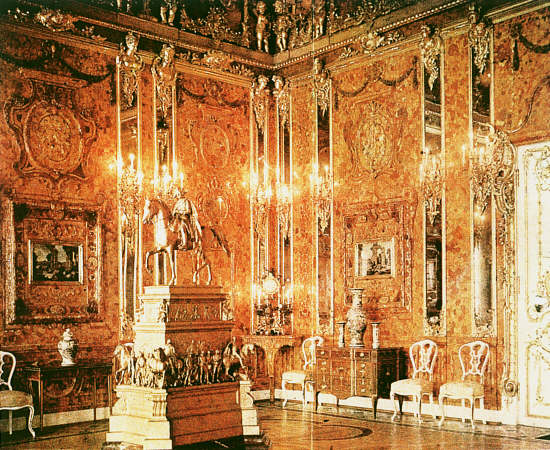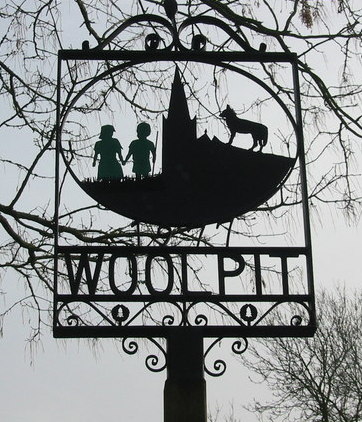The Amber Room (In English sometimes known as Amber Chamber, German: Bernsteinzimmer) in the Catherine Palace of Tsarskoye Selo near Saint Petersburg is a complete chamber decoration of amber panels backed with gold leaf and mirrors. Due to its singular beauty, it was sometimes dubbed the "Eighth Wonder of the World".
Before it was lost, the original Amber Room represented a joint effort of German and Russian craftsmen. Construction of the Amber Room began in 1701 to 1709 in Prussia. The room was designed by German baroque sculptor Andreas Schlüter and constructed by the Danish amber craftsman Gottfried Wolfram and remained at Charlottenburg Palace until 1716 when it was given by Prussian king Friedrich Wilhelm I to his then ally, Tsar Peter the Great of the Russian Empire. In Russia it was expanded and after several renovations, it covered more than 55 square meters and contained over six tons of amber. The Amber Room was looted during World War II by Nazi Germany and brought to Königsberg. Knowledge of its whereabouts was lost in the chaos at the end of the war.
In 1979 efforts began to rebuild the Amber room at Tsarskoye Selo. In 2003, after decades of work by Russian craftsmen, financed by donations from Germany, the reconstructed Amber Room was inaugurated in the Catherine Palace in Saint Petersburg, Russia.
The Baltic region is known to contain huge deposits of amber. In fact, some estimates claim up to 80% of the world’s supply of the fossilized tree resin is located there. Its warm, golden glow is prized by artists and collectors alike. The highest quality of amber has been used for ornamental and jewelry production since Neolithic times.
Perhaps the best known and inspired use of amber was the creation of the Amber Room in 1709 by designer Andreas Schluter and amber craftsman Gottfried Wolfram.
Upon completion, the Amber Room was proudly displayed at the Charlottenberg Palace in Prussia. It was considered a true masterpiece. During a visit to Prussia in 1712, Czar Peter the Great of Russia confided in King Friedrich Wilhelm I on how much he adored this stunning room. In order to cement an alliance against Sweden, King Wilhelm I presented the Amber Room as a gift to Czar Peter the Great. The royal gift was shipped over water to Russia in 18 large boxes in 1716.
Once in Russia, the Amber Room was further built upon and renovated. In its final form in 1763, the Amber Room spanned 55 meters and contained over six tons of amber. It was located in the Catherine Palace of St. Petersburg and admired by the lucky few who were able to see it. The feeling one would get visiting the Amber Room can be described as the following:
“When the daylight was shining through the wide windows, it replaced hundreds of lighting candles and created thousands of reflections in the mirrors. This light made multicolored Amber walls shine more beautiful than gold and created a deeply lasting impression never forgotten by any visitor.”
Most words cannot describe the awe someone would feel while in this room. In fact, many considered the Amber Room the “Eighth Wonder of the World”.
Disappearance of Amber Room
Before it was lost, the original Amber Room represented a joint effort of German and Russian craftsmen. Construction of the Amber Room began in 1701 to 1709 in Prussia. The room was designed by German baroque sculptor Andreas Schlüter and constructed by the Danish amber craftsman Gottfried Wolfram and remained at Charlottenburg Palace until 1716 when it was given by Prussian king Friedrich Wilhelm I to his then ally, Tsar Peter the Great of the Russian Empire. In Russia it was expanded and after several renovations, it covered more than 55 square meters and contained over six tons of amber. The Amber Room was looted during World War II by Nazi Germany and brought to Königsberg. Knowledge of its whereabouts was lost in the chaos at the end of the war.
In 1979 efforts began to rebuild the Amber room at Tsarskoye Selo. In 2003, after decades of work by Russian craftsmen, financed by donations from Germany, the reconstructed Amber Room was inaugurated in the Catherine Palace in Saint Petersburg, Russia.
The Baltic region is known to contain huge deposits of amber. In fact, some estimates claim up to 80% of the world’s supply of the fossilized tree resin is located there. Its warm, golden glow is prized by artists and collectors alike. The highest quality of amber has been used for ornamental and jewelry production since Neolithic times.
Perhaps the best known and inspired use of amber was the creation of the Amber Room in 1709 by designer Andreas Schluter and amber craftsman Gottfried Wolfram.
Upon completion, the Amber Room was proudly displayed at the Charlottenberg Palace in Prussia. It was considered a true masterpiece. During a visit to Prussia in 1712, Czar Peter the Great of Russia confided in King Friedrich Wilhelm I on how much he adored this stunning room. In order to cement an alliance against Sweden, King Wilhelm I presented the Amber Room as a gift to Czar Peter the Great. The royal gift was shipped over water to Russia in 18 large boxes in 1716.
Once in Russia, the Amber Room was further built upon and renovated. In its final form in 1763, the Amber Room spanned 55 meters and contained over six tons of amber. It was located in the Catherine Palace of St. Petersburg and admired by the lucky few who were able to see it. The feeling one would get visiting the Amber Room can be described as the following:
“When the daylight was shining through the wide windows, it replaced hundreds of lighting candles and created thousands of reflections in the mirrors. This light made multicolored Amber walls shine more beautiful than gold and created a deeply lasting impression never forgotten by any visitor.”
Most words cannot describe the awe someone would feel while in this room. In fact, many considered the Amber Room the “Eighth Wonder of the World”.
Disappearance of Amber Room



